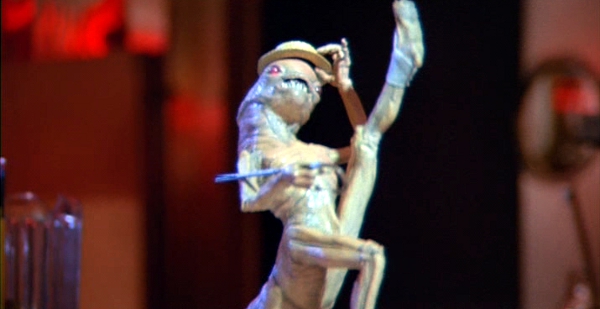-
Posts
2,989 -
Joined
-
Last visited
Content Type
Profiles
Forums
Developer Articles
KSP2 Release Notes
Bug Reports
Posts posted by Green Baron
-
-
The first image is from a cinematic movie, and it is far from reality.
The second one is from real life. And it shows the area in the radio spectrum, immediately above the event horizon of a rotating Kerr black hole with an accretion disk just as it was postulated by theory. This is outstanding. For the first time we have a real world image from something that just a few decades ago few people assumed to even exist.
There are numerous images and examples of what the direct environment of the event horizon should look like, depending on the orientation, if it is rotating or not, has an accretion disk or not etc. Some are discussed, including alternatives, in the papers.
https://eventhorizontelescope.org/simulations-gallery
Now actually with a little more real world background than before, as the example we have behaves like simulated. I find this really cool.
We can expect more, and possible different looking black holes, with better instruments and techniques. Sgr A* may be the next. The even talk about stellar black holes, but that may still be future music.
I want a radio telescope (and if we're already there an optical one as well) in each earth/moon or earth/sun lagrange point :-)
-
If i understand it right (and i don't pretend to do so), they took several explanations for the jet and the disc into account, and compared them with a set (the "library") of several thousand simulations. Whether all the explanations are relativistic realistic, i cannot tell (former archaeologist, eh), but anyway they did, and out came the one that explains jet, disc and angular momenta best. *drumroll* and it was the one GR predicted for a Kerr black hole.
There is no job offer for a pöt on the EHT home page ... i would certainly send in my application :-)
-
Yes, the black hole's rotation and spacetime distortion plays the bigger part. But, in this case, both, the disc and the hole co-rotate.
Didn't want to overcomplicate above ...
Edit: and, overall, from paper number I's abstract: "The asymmetry in brightness in the ring can be explained in terms of relativistic beaming of the emission from a plasma rotating close to the speed of light around a black hole."
"Relativistic beaming" being the signal amplification for the approaching part as well as the dampening for the retreating part. So, the Doppler argument is untouched.
-
3 hours ago, Cassel said:
Well, what about the event horizon? If it's a black hole, where is it? It should be visible in the form of a light, thin ring.
ItThe event horizon is inside the dark area, having a little less than half its diameter. It itself is invisible.There is no ring because this is not an optical image. Measured were the radio waves from the disc alone, in a very narrow band around ~1.3mm lambda and such a subtle structure is below the resolution power of the Interferometer. Resolution power is demonstrated in some of the images with a small white circle.
They will try in the future to observe at shorter wavelengths, but for this the dishes must be extremely smooth in order not to introduce errors from unevenness. Shorter wavelengths (higher frequency) would mean better resolution with given diameter (resolution ~= lambda/diameter).
-
-
Good job, SpaceX !
-
Ok, to make that clear. When looking from above on an object that is turning clockwise, its rotational axis vector (here the z-axis) points away from the observer. That is a left handed coordinate system for the ones like me who fight with 3D stuff and the like (and are about to loose).
M87's black hole rotational axis points away from us, in reference to the image we all stare at since yesterday, to the lower left, by 17° from the observational eyesight (the camera's front vector). So, seeing positive z as the normal of the rotational plane that is spanned up by the accretion disc, it's anti normal points towards us, to the upper right, by 17°. The jet pointing towards us marks that vector, which is, in terms of KSP, the anti-normal, in terms of 3D graphics it is simply a unary- on the normal (be it normalized or not).
Were we to implement an algorithm to cull the jet from our viewport, we would have to define near and far plane, camera front, x-axis deviation and y-axis deviation and compare them to our selection of objects we want to draw.
That's where i got stuck.
*crack zosh*
good night everybody :-)
-
The 17° is mentioned in paper number V. I put it in a spoiler in a post of mine on the previous page. It was first derived from the jet by VLBI in 2018. It is not an invention of mine ;-)
A direct link to the cited work:
https://iopscience.iop.org/article/10.3847/1538-4357/aaafcc/meta
The paper mentions as well a "counterjet", which is shown in many images, but not as clearly accentuated as the one pointing towards us.
-
Hey, what's that left-handed guy doing there in the background ?
Anyway:

-
16 minutes ago, sh1pman said:
... the rotation axis is perpendicular to the line of sight ....
At these speeds, combining pure euclidian geometry and spacetime effects, even a slight angle causes magnitudes of difference in signal strength. The whole thing is actually rotating almost face-on, with a deviation of 17°. There is an image showing the orientation of the arm of the jet aiming towards us. The opposite is invisible.

(turn it to the left ~90° to align with the EHT image)
The bright point is the galaxy M87.
Space is mindbogglingly huge.
-
1 hour ago, Cassel said:
edit:
Although I probably do not understand it correctly. If the magnetic waves of the black hole are directed towards us, then this picture does not make any sense at all. What we should see is the ring of exactly the same brightness likeThere are two different things here:
The magnetic field lines do not directly create the image. Magnetic fields develop in the accretion disc of plasma (charged particles) from differential rotation speed being faster on the inner and slower on the outer part. They are twisted by the rotating black hole (through mechanisms i don't completely understand without diving deeper into it) in a form that they accelerate material from the disc towards the poles and from there out into space. The orientation of this jet, assuming that it is rectangular to the disc, enables them to calculate the disc's orientation.
The jet has been observed, and its orientation determined, long ago. The picture now obtained by the EHT correlates very well with that older observation, enabling them to give an estimate of an angle of the disk in respect to the line of sight from here to there (the 17° towards the north-northeast mentioned above).
The image, on the other hand, is obtained from material from the rotating disk, as explained above.
So, two separate things, magnetic fields - observation of radio waves.
11 minutes ago, Starstruck69 said:Baron this has been a great thread some great info/links here. Good job, have you slept yet? You seem to have been very busy

Thanks for asking :-)
I am UTC (Canaries).
I spent some time (~3 hours) reading the articles and assimilating what was possible, but in principle and foremost i am at the pc right now because i am self teaching me graphics programming (and fighting against some problems), so i have been on the pc most of the time. OT ... sorry.
-
30 minutes ago, Starstruck69 said:
You don't have to be super clever to work in the field....
Sorry for my being unclear. I was not referring to the authors of the EHT collaboration and the papers they produced, that is outstanding work. It was @p1t1o's remark about second hand sources, that on every site he read the description/explanation of what was presented was slightly different. With that, so i assumed, he meant pop science articles and social media sites commenting on the news. And, i may say, i have some experience with journalists :-) They can't know everything about everything, just like us, they read and try to understand, and sometimes they are good, sometimes we are better in that. And i wasn't 100% serious.
The direct outcome of all this is actually pretty simple: After more than 20 years of preparation the EHT has achieved an unprecedented angular resolution, with newest technology available since recently for data collection as well as computing power (it was the first time since years that i heard someone mentioning Moore's law :-)). The effort has strengthened and confirmed again the predictions of General Relativity.
More can be expected soon(tm).
Schwartzchild and Eensteen can be happy.
-
Yeah, well, it was written with some humour :-) If people like Ainsteene more, i know who's meant.
To be clear: the ring does not show optical data from an imaging optical telescope, it is processed data from overlaid radio signals, obtained by receivers all around the world. What is so outstanding is the resolution.
Where the ring is brighter, the radio signals have been stronger. The edge of the dark centre is where photons are going around the event horizon very closely (like 2 Schwarzschild radii). The black hole itself is rotating very fast, and together with the doppler effect this causes the southwest of the ring to appear brighter (signals being stronger) than the northeast.
Spoiler(4) The ring is brighter in the south than the north. This can be explained by a combination of motion in the source and Doppler beaming. As a simple example we consider a luminous, optically thin ring rotating with speed v and an angular momentum vector inclined at a viewing angle i > 0° to the line of sight. Then the approaching side of the ring is Doppler boosted, and the receding side is Doppler dimmed, producing a surface brightness contrast of order unity if v is relativistic. The approaching side of the large-scale jet in M87 is oriented west–northwest (position angle
 in Paper VI this is called
in Paper VI this is called  ), or to the right and slightly up in the image. Walker et al. (2018) estimated that the angle between the approaching jet and the line of sight is 17°. If the emission is produced by a rotating ring with an angular momentum vector oriented along the jet axis, then the plasma in the south is approaching Earth and the plasma in the north is receding. This implies a clockwise circulation of the plasma in the source, as projected onto the plane of the sky. This sense of rotation is consistent with the sense of rotation in ionized gas at arcsecond scales (Harms et al. 1994; Walsh et al. 2013). Notice that the asymmetry of the ring is consistent with the asymmetry inferred from 43 GHz observations of the brightness ratio between the north and south sides of the jet and counter-jet (Walker et al. 2018).
), or to the right and slightly up in the image. Walker et al. (2018) estimated that the angle between the approaching jet and the line of sight is 17°. If the emission is produced by a rotating ring with an angular momentum vector oriented along the jet axis, then the plasma in the south is approaching Earth and the plasma in the north is receding. This implies a clockwise circulation of the plasma in the source, as projected onto the plane of the sky. This sense of rotation is consistent with the sense of rotation in ionized gas at arcsecond scales (Harms et al. 1994; Walsh et al. 2013). Notice that the asymmetry of the ring is consistent with the asymmetry inferred from 43 GHz observations of the brightness ratio between the north and south sides of the jet and counter-jet (Walker et al. 2018).
The ring is seen almost face on, the upper-right being tilt a little away from us (~17°), and rotating clockwise. That makes the lower part of it moving slightly towards us, the upper part moving away. This, plus to large degree spacetime distortions explains the observed differences in signal strengths.
SpoilerDespite these uncertainties, many of the models produce images with similar morphology that is consistent with EHT2017 data. This suggests that the image shape is controlled mainly by gravitational lensing and the spacetime geometry, rather than details of the plasma physics.
(citings from paper V)
Oops, ninja'd
-
Edit: I would interpret this as an evidence that the authors of these articles aren't cleverer than ourselves

Overview on the EHT homepage:
https://eventhorizontelescope.org/
and special issue of the ApJ Letters, with summary:
https://iopscience.iop.org/journal/2041-8205/page/Focus_on_EHT
Scroll down for the links to the detail papers, which are pretty comprehensible.
--------------
I read that the 2018 observation campaign fell victim to adverse weather conditions, 2019 had technical problems. Hopes are on next year's campaign with added telescopes and probably refined methods of analysis.
-
-
[unimportant remark about Schwarzschild deleted]
-
Sgr A* changes quickly, even during one session, while M87 stays still. That complicates data evaluation.
"very soon" they say
very TM :-)
-
Our central black hole has a slightly greater angular size than the M87 one, as observed from earth, but it is behind thick interstellar clouds.
The dark depression in the image presented is about double the size of the actual event horizon that would fit the mass 6.5 billion solar masses.
-
27 minutes ago, Ultimate Steve said:
Wait, so will we get the Sagittarius pictures today or later?
They mention somewhere that an image of SgrA* drawn out of data from the 2017 campaign can be expected. If i understood it right, some adjustments must be made to the data crunching, so it may take some more time (interpretation mine).
Also, only a part of the petabytes of data has been used for the analyses presented today.
When the French NOEMA and the Greenland Telescope will join (this and the next year), there will be another leap in sensitivity, which may enable them to actually do "movies" of the swirling disc.
Within the limits of the uncertainties (that may be pushed further in upcoming campaigns and further refinement of the methods), the conformity with the predictions of GR (here: Kerr metric) is amazing, so it is said :-)
-
A sixth paper that is not in the "special edition" of ApJ letters above:
https://iopscience.iop.org/article/10.3847/2041-8213/ab1141
They are all openly licensed and surprisingly understandable.
-
Here's food:
https://iopscience.iop.org/journal/2041-8205
Looks like being open access.
Have fun :-)
(retreats in a cave for reading)
-
9 minutes ago, Starstruck69 said:
On a more serious note i wonder if they use shake and vac?
In opposition to stir and vac ?
-
Gas pipeline ?

-
3571






Imaging a black hole - the EHT
in Science & Spaceflight
Posted
Guys, you are comparing an artist's impression with real world images.
I hoped i could keep this sciency, but sadly this is impossible.
You have made it, i am out. Byebye.